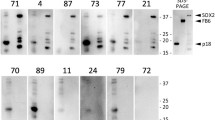Summary
Murine IgG1 monoclonal antibodies (mAbs), ITK-2 and ITK-3, were generated against a small-cell lung cancer (SCLC) cell line. Enzyme-linked immunosorbent assay using a variety of established cell lines as substrates, immunoperoxidase staining of freshly frozen tissue sections, and fluorescence-activated cell sorter analysis of peripheral blood leukocytes showed that these mAbs recognize a part of the SCLC-associated cluster 1 antigen. In immunoprecipitation studies, both ITK-2 and ITK-3 bound to a 145-kDa glycoprotein of SCLC cell membrane extracts, as did MOC-1 and NKH-1, which both recognize the cluster 1 antigen. However, because the binding of125I-labeled ITK-2 to SCLC cells was not inhibited by MOC-1 or NKH-1, the binding site of ITK-2 on SCLC cells appeared to be different from that of either MOC-1 or NKH-1. Unexpectedly, binding of125I-labeled ITK-2 to SCLC cells increased in the presence of ITK-3. This ITK-3-induced increase in ITK-2 binding was due partly to an increase in the number of binding sites for ITK-2 on SCLC cells. Addition of ITK-3 may, therefore, improve the effectiveness of ITK-2-based tumor detection or therapy.
Similar content being viewed by others
References
Beverley PCL, Souhami RL, Bobrow L (1988) Results of the central data analysis. Lung Cancer 4 [Suppl]: 1
De Leij L, Poppema S, Nulend JK, TerHaar A, Schwander E, Ebbens F, Postmus PE, The TH (1985) Neuroendocrine differentiation antigen on human lung carcinoma and Kulchitski cells. Cancer Res 45: 2192
Epstein AL, Marder RJ, Winter JN, Stathopoulos E, Chen F-M, Parker JW, Tailor CR (1987) Two new monoclonal antibodies, Lym-1 and Lym-2, reactive with human B-lymphocytes and derived tumors, with immunodiagnostic and immunotherapeutic potential. Cancer Res 47: 830
Fraker PJ, Speck GC Jr (1978) Protein and cell membrane iodinations with a sparlingly soluble chloramide, 1, 3, 4, 6-tetrachloro-3-6-diphenylglycoluril. Biochem Biophys Res Commun 80: 849
Hercend T, Griffin JD, Bensussan A, Schmidt RE, Edoson MA, Brennan A, Murray C, Daley JF, Schlossman SF, Ritz J (1985) Generation of monoclonal antibodies to a human natural killer clone. J Clin Invest 75: 932
Hirano T, Hirohashi S, Kunii T, Noguchi M, Shimosato Y, Hayata Y (1989) Quantitative distribution of cluster 1 small cell lung cancer antigen in cancerous and non-cancerous tissues, cultured cells and sera. Jpn J Cancer Res 80: 348
Hsu S, Raine L, Fanger H (1981) Use of avidin-biotin-complex (ABC) in immunoperoxidase techniques. J Histochem Cytochem 29: 577
Kawase I, Komuta K, Ogura T, Fujiwara H, Hamaoka T, Kishimoto S (1985) Murine tumor cell lysis by antibody-dependent macrophage-mediated cytotoxicity using syngeneic monoclonal antibodies. Cancer Res 45: 1663
Kubo R, Pellanne ML (1983) Tunicamycin inhibits the expression of membrane IgM in the human lymphoblastoid cell line Daudi. Mol Immunol 20: 67
Laemmli UK (1970) Cleavage of structural proteins during the assembly of the head of bacteriophage T4. Nature 227: 680
Morstyn G, Ihde DC, Lichter AS, Bunn PA, Carney DN, Glatstein E, Minna JD (1984) Small cell lung cancer 1973–1983: early progress and recent obstacles. Int J Radiat Oncol Biol Phys 10: 515
Mountain CF (1978) Clinical biology of small cell lung carcinoma: Relationship to surgical therapy. Semin Oncol 5: 272
Schol DJ, Mool WJ, Van der Gugten AA, Wagenaar SS, Hilger J (1988) Monoclonal antibody 123C3, identifying small cell lung carcinoma phenotype in lung tumors, recognizes mainly, but not exclusively, endocrine and neuron-supporting normal tissues. Int J Cancer [Suppl] 2: 34
Takahashi T, Ueda R, Song X, Nishida K, Shinzato M, Namikawa R, Ariyoshi Y, Ohta K, Kato K, Nagatsu T, Imaizumi M, Abe T, Abe T, Takahashi T (1986) Two novel cell surface antigens on small cell lung carcinoma defined by mouse monoclonal antibodies NE25 and PE35. Cancer Res 46: 4770
Tanio Y, Watanabe M, Inoue T, Kawase I, Shirasaka T, Ikeda T, Hara H, Masuno T, Saito S, Kawano K, Kitamura H, Kubota K, Kodama N, Kawahara M, Sakatani M, Furuse K, Yamamoto S, Kishimoto S (1990) Chemo-radioresistance of small cell lung cancer cell lines derived from untreated primary tumors obtained by diagnostic bronchoscopy. Jpn J Cancer Res 81: 289
Watanabe J, Okabe T, Fujisawa M, Takaku F, Hirohashi S, Shimosato Y (1987) Monoclonal antibody that distinguishes small-cell lung cancer from non-small-cell lung cancer. Cancer Res 47: 826
Watanabe J, Okabe T, Fujisawa M, Takaku F, Fukayama M (1987) Isolation of small cell lung cancer-associated antigen from human brain. Cancer Res 47: 960
Author information
Authors and Affiliations
Rights and permissions
About this article
Cite this article
Saito, S., Inoue, T., Kawase, I. et al. Two monoclonal antibodies against small-cell lung cancer show existence of synergism in binding. Cancer Immunol Immunother 33, 165–170 (1991). https://doi.org/10.1007/BF01756137
Received:
Accepted:
Issue Date:
DOI: https://doi.org/10.1007/BF01756137




